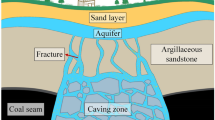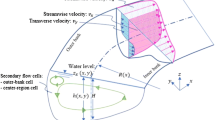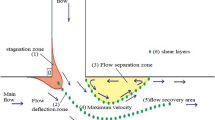Abstract
A finite element method for analysis of pollutant dispersion in shallow water is presented. The analysis is divided into two parts:(1) computation of the velocity flow field and water surface elevation, and (2) computation of the pollutant concentration field from the dispersion model. The method was combined with an adaptive meshing technique to increase the solution accuracy, as well as to reduce the computational time and computer memory. The finite element formulation and the computer programs were validated by several examples that have known solutions. In addition, the capability of the combined method was demonstrated by analyzing pollutant dispersion in Chao Phraya River near the gulf of Thailand.
Similar content being viewed by others
References
Rastogi A K, Rodi W. Predictions of heat and mass transfer in open channels[J]. J Hydr Eng Div-ASCE, 1978,104(HY3):397–420.
Vreugdenhill C B, Wijbenga J H. A computation of flow patterns in rivers[J]. J Hydr Eng Div-ASCE, 1982,108(HY11):1296–1310.
Demuren A O, Rodi W. Calculation of flow and pollutant dispersion in meandering channels [J]. J Fluid Mech, 1986,172:63–92.
Molls T, Chaudhry M H. Depth-averaged open channel flow model [J]. J Hydraul Eng ASCE,1995,121(6):453–465.
Borthwick A G L, Akponasa G A. Reservoir flow prediction by contravariant shallow water equations[J]. J Hydraul Eng-ASCE, 1997,123(5):432–439.
Zhou J G, Goodwill I M. A finite volume method for steady state 2D shallow water flows [J]. Internet J Numer Method H, 1997,7( 1):4–23.
Yu L, Righetto A M. Depth-averaged turbulence {ie1584-1} model and applications[J]. Advances in Engineering Software,2001,32(5):375–394.
Zienkiewicz O C, Heinrich J C. A unified treatment of steady-state shallow water and two-dimensional Navier-Stokes equations-finite element approach [J]. Comput Method Appl M, 1979,17/18:673–698.
Cochet J F, Dhatt D, Hubert G, Touzot G. River and estuary flows by a new penalty finite element [A]. In: Kawai T (ed). Finite Element Flow Analysis [C]. University of Tokyo Press, Tokyo,1982,563–570.
Leclerc M, Bellemare J, Dumas G, Dhatt G. A finite element model of estuarian and river flows with moving boundaries[J]. Adv Water Resour,1990,13(4):158–168.
Shrestha P L. An integrated model suite for sediment pollutant transport in shallow lakes[J]. Advances in Engineering Software, 1996,27(3):201–212.
Tabuenca P, Vila J, Cardona J, Samartin A. Finite element simulation of dispersion in the Bay of Santander[J]. Advances in Engineering Software,1997,28(5):313–332.
Peraire J, Vahjdati M, Morgan K, Zienkiewicz O C. Adaptive remeshing for compressible flow computation[J]. J Comput Phys,1987,72(2):449–466.
Dechaumphai P, Morgan K. Transient thermal-structural analysis using adaptive unstructured remeshing and mesh movement [A]. In: Thermal Structures and Materials for High-Speed Flight[C]. American Institute of Aeronautics and Astronautics, Washington D C, 1992,205–228.
Dechaumphai P. Adaptive finite element technique for heat transfer problems[J]. Journal of Energy, Heat and Mass Transfer,1995,17(2):87–94.
Dechaumphai P. Finite Element Method for Computational Fluid Dynamics [M]. Chulalongkorn University Press, Bangkok,2002.
Author information
Authors and Affiliations
Corresponding author
Additional information
Communicated by ZHOU Zhe-wei
Project supported by the Thailand Research Foundation (TRF)
Rights and permissions
About this article
Cite this article
Otarawanna, S., Dechaumphai, P. Adaptive finite element method for analysis of pollutant dispersion in shallow water. Appl. Math. Mech.-Engl. Ed. 26, 1574–1584 (2005). https://doi.org/10.1007/BF03246266
Received:
Revised:
Issue Date:
DOI: https://doi.org/10.1007/BF03246266




